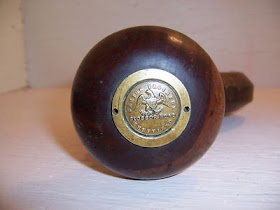Now that I can walk around the garage floor, I thought it would be a good place to work since de-rusting can get some messy regardless of methods used .
So I spray liberally the jointer cast iron bed and a handsaw I'm working on.
Throw ball with Rudy while I leave it do its trick (WD-40 not Rudy :-)
Went to get a new razor scraper cause I have no idea were mine is right now..
A few scrape and see how easily it is coming off
Surface rust is no biggie, except if left unchecked for a while
it will eventually cause pitting and that would be a bad thing. A coat of wax later on will protect it.
The saw I'm working on is one of them I picked the other day it shows a faint etch, Im curious to see what it is.
My usual arsenal for saw plates, WD-40, safety razor scraper, and lots of paper towels. I also used a green Scotch pad, but I stay clear of the etch area with it.
These dome screws are sometimes a bugger to remove, since the there is nothing to hold the screw in place. 3 out of 4 came out easily, the last one just spins in place. I had to resort to a piece of wood and two clamps to secured it while unscrewing.
Success
The dome screws first came out in 1876.
This design was patented by Disston on Aug 29th 1876.
The Medallion has female thread (shown on left)
The threaded stud is rather small and being brass can be twisted off...
In the 1914 catalog, you can buy replacement medallions, but only with Warranted superior, not Disston on it. Available in two sizes:
Large 1 inch and Small 13/16 inch. Notice also how the dome screws have changed. The medallions now have a thread stud
That change came about with the Glover nut patent of 1887
So what is the scoop with that saw?
after some light scraping with the razor an etch start to appear...
The etch reads:
Special saw steel Patent taper ground
VICTOR
Made in Canada
Never heard of it, so lets look at the medallion;
Recognize the unmistakable Disston Keystone logo?
It measure 13/16 in in diameter and the rolled edge is 3/32 wide.
It is made of brass nickel plated
So what is the deal with Warranted Superior on saws?
There are two very different usage of this statement. On British saws, it denoted often a truly superior products, while ironically, on American saws, it denoted a second line product from the big makers; Namely Disston, Atkins and Simonds.
Most American saw makers were purchased by one of these three makers, listed above, and continued with their other makers saws except that they would not stamped them with their "good name" and instead put their Warranted medallion on them. Are they a lesser product? Arguably, some are as good as the major labels manufacturers, but they did not wanted to lessen their good name by putting it on a less expensive products. Brand name loyalty was (and may still is) strong in those days. Disston at their peaks easily dominated the market at about 60 % of all saws sold...Worldwide! Ever wondered why they are so prolific out there? Now you know. So if you find any American Warranted superior saws, chances are pretty good it was made by Disston!
This Jackson backsaw (second line from Disston) from my "ahem" assortment, featured the typical Eagle first used on Warranted Superior medallions by Disston
A more modern WS American medallion
While this British Simpson tenon saw has a mythical slayer
Typically, British WS medallions have a coat of arms on them.
That one from a combination saw from Adelaide saw works
Back to Disston;
Later Disston made WS medallions, have a circle of dots, star at the 3 and 9 o'clock position and with or without the eagle in the middle, then a keystone was put in the middle instead of an eagle. The 1906 catalog shows the eagle while the 1911 has the keystone showing on their replacements medallions. The 1914, and 1923 catalog shows nothing in the center (no eagle nor keystone)
This medallion is then from approx 1911. By then most small guys were now secondary lines of the big guys (Disston, Atkins, Bishop and Simonds)
This saw measured 24 in at the tooth line, making it a full size handsaw, as opposed to a panel saw (20-22 in). The rosewood handle has some wheat carving on it and fit my hand just right. Being made of special saw steel (whatever that is) and patent taper ground are all signs of a good saw. She is a keeper :-)
In case you are wondering, no I did not finish cleaning it, I was sweating buckets so I quit and retreated to the computer to research it.
Bob, who was worry I'll catch hell because I forgot to changes my clothes before making a rusty mess... old habits die hard I guess ...





































































